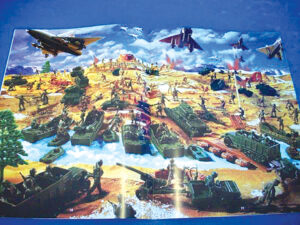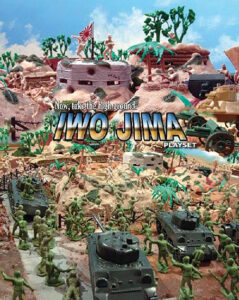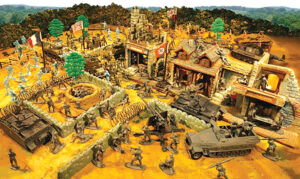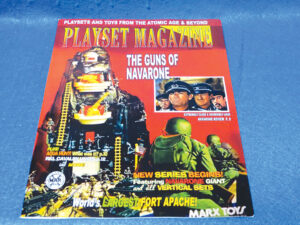 By Robert Reed
By Robert Reed Over a period of approximately 15 years, from the late 1940s into the 1970s, military playsets were one of the nation’s most popular and prolific toys.
Scores and scores of the sets were produced by the Louis Marx Company which was the leader in playset manufacturing and marketing. Military sets in particular probably outdistanced their space, farm and prehistoric sets in sales during that period.
Hallmarks of the numerous Marx military playsets were the enduring plastic soldiers and their accompanying metal buildings.
“As with cowboy-and-Indian figures, miniature soldier figures would be just about the closest boys ever got to playing with dolls,” observe Gil Asakawa and Leland Rucker, co-authors of The Toy Book. “Thanks to the mass-produced capabilities of injection-molded plastic, entire armies of green soldiers, or gray and black knights, or red and blue Revolutionary War figures were available in stores or through comic-book mail order.”
But it wasn’t just the colors that made these military playsets appeal so strongly to youngsters, it was the vastness of their numbers. “Marx’s early sets weren’t particularly inspiring as to subject,” notes toy historian Richard O’Brien author of The Story of American Toys, “but their quality and the quantity of their components made them catch on quickly. A single Marx set contained more toys and accessories than most of the kids of the 1920s and 1930s had owned throughout the duration of their childhood.”
 As a “stunning” example O’Brien cites the U.S. Army Training Set first issued in 1951, “for $5.95 one got 145 pieces including 100 plastic soldiers. During the deepest days of the Depression, 100 soldiers alone would have cost $5.”
As a “stunning” example O’Brien cites the U.S. Army Training Set first issued in 1951, “for $5.95 one got 145 pieces including 100 plastic soldiers. During the deepest days of the Depression, 100 soldiers alone would have cost $5.” The fabled set also included a metal headquarters building, machine guns, tents, stacked rifles, bazookas, flags, trees, rocks, scout car, army half-track, 16 sections of fencing, a desk, swivel chair, switchboard, rifle rack, crate, side chairs, map table, bench, a file cabinet and even a wastebasket.
Other early military playsets included Battleground which was advertised in the Montgomery Ward catalog, the Authorized Gallant Men, Iwo Jima, and the previously mentioned Revolutionary War Set.
The Battleground set was somewhat more unique than many of the others in that it also offered German troops along with American troops. Other sets which also provided ‘enemy’ soldiers included D-Day Army Set, Desert Patrol, Beachhead Landing, Tank Battle, and the World War II playset. The WWII set sold by Sears also included French, British, and Russian troops.
During the early 1960s, Ideal Toy Company also got into military playsets, including one specialty series. “Ideal produced nine different diorama playsets with working features and called the series Battle Action,” according to Bill Bruegman in Toys of the Sixties. “Each set came with three inch soldiers, although these were also sold separately.”
Individual set include Fighter Jet Strip, Sniper Post, Check Point, War Field and Fighting Men, Twin Howitzers, Mined Bridge, Booby Trap Road, Machine Gun Nest, and Road Block. These sets were also relatively intricate and detailed. Road Block, for example, featured a spring-activated falling tree and a machine gun which produced sounds, plus three soldiers and a jeep.
Bruegman also points out that the Battle Action Playsets came in large window display boxes featuring a single set. Later larger boxes with fold-open lids contained two or more sets.
 Ideal also issued a big plastic truck and cannon in the 1960s. “It’s big, it’s unbreakable, it’s polyethylene,” Ideal proclaimed in marketing the Army Truck and Cannon. The truck had a removable canopy and the cannon fired cannon balls. The outfit was slightly bigger than most of the other playset models but still sometimes workable with the others.
Ideal also issued a big plastic truck and cannon in the 1960s. “It’s big, it’s unbreakable, it’s polyethylene,” Ideal proclaimed in marketing the Army Truck and Cannon. The truck had a removable canopy and the cannon fired cannon balls. The outfit was slightly bigger than most of the other playset models but still sometimes workable with the others. Technically, some of the G.I. issues also qualified as playsets. The G.I. Joe Super Adventure sold by Sears in the latter 1960s $12.95 included “all the accessories needed to take G.I. Joe on three exciting adventures.” And there was the G.I. Adventure Headquarters for $13.99 which included a three- room building, telegraph key, map, and other accessories.
Comic books also offered a steady supply of mail-order military playsets during the 1960s, but of considerably lesser quality. Lucky Products offered Toys Soldiers in a Foot Locker for about one dollar. The plastic soldiers were two inches tall and the footlocker was a cardboard box. Similar advertisements offered up to 100 pieces in the sets including tanks, jeeps, and even waves and wacs.
In 1962 Remco issued the Whirlybird Helicopter set which included a battery-operated helicopter, and a 25-member attack force complete with jeep, tank and truck. They followed that in 1964 with three different World War I playsets. One, Doughboy and Air Aces, came with biplanes and several soldiers.
 Still the vast majority of the better military playsets came from Marx. The company made numerous versions of the U.S. Army Training Center some of which included a Post Exchange, flag pole, and Company C supply building.
Still the vast majority of the better military playsets came from Marx. The company made numerous versions of the U.S. Army Training Center some of which included a Post Exchange, flag pole, and Company C supply building. Other sets marketed in multiple versions included Marine Beachhead, Military Academy, American Patrol, Army Barracks, Navarone Mountain Battleground, and the Battle of the Blue and Gray.
Marx also offered the Battleground Convoy Set, the D.E.W. Defense Line Artic Satellite Base, Giant Battleground, and Strategic Air Command which was often combinations of various previously issued sets.
“The Louis Marx Toy Company was the leading producer of this type of toy and was responsible for most of the higher valued sets in this category,” concludes Rick in the book, Garage Sale Gold.
While “Multi-Products and several other toy companies produced similar figures even by the pound,” adds Koch, “none have measured up to the most valuable (Marx) sets.”















Follow Us